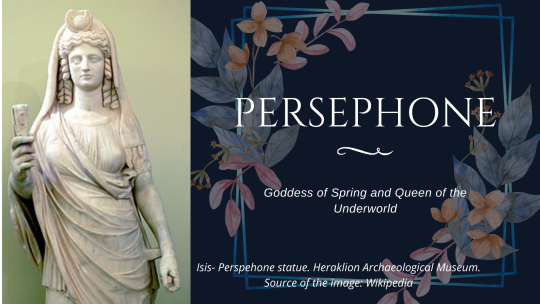Persephone, goddess of Spring and queen of the Underworld
Author's note: The following article was published in Spanish language on my Blurt blog, in May 25th, 2021.

Banner made with Canva.
In the last post we talked about Hades, god of wealth and lord of the Underworld. We explored the cult devoted to him on Greece and Rome as well as we approached on the most important myth of his, the abduction of a young goddess of whom we dedicate today's post: Persephone.
Who was Persephone on the Greco-Roman Pantheon?
According to Gordon Cheers (2019), Kore, as this divinity was also known, was the daughter of Zeus and Demeter, goddess of agriculture. Hence, she was the goddess of spring and, through her marriage to Hades, the queen of the Underworld. Both her and Demeter are credited with the origin of the seasons of the year.
About her descendants with Hades, some scholars point out that their union was infertile. However, other mention Macaria, goddess of non-violent death, and Melinoe, goddess of ghosts, as her children with the lord of the Underworld. On her third child, Zagreus , Ángel María Garibay (2020) mentions that the father of this young god was Zeus, who seduced Persephone by disguising himself as a snake or Hades himself as well.
The abduction: myth of renovation
An important aspect that Cheers (2019) points out regarding the abduction myth is its link with the annual renewal of Nature, reflected in the change of seasons. The quantity of grains of pomegranate that Persephone consumed, in effect, reflects the type of climate that prevails in each Greek region.
Cult in Greece and Rome
As the goddess of Spring, Persephone held a prominent place within the Pantheon and was an object of worship in various regions of Greece, particularly in Eleusis, a city in Attica near Athens. According to Yidy Páez Casadiegos (2020), the Eleusinian Mysteries were carried out as a way to commemorate the abduction of Persephone and Demeter's passage through that city during the incessant search for her daughter. They used to be celebrated twice a year, in Spring and Autumn, symbolizing the different episodes of the mythical event.
As the queen of the Underworld, her figure was as feared as that of Hades, since she shared with her husband the function of protecting the secrets of the dead. It's likely that she received the same cult as Hades on her holidays. The main temples devoted to her were in Athens and in Thebes, where the Tesmophoria, another celebration where she was worshiped with Demeter and in which only women participated, was celebrated.
During her worship in any of the aforementioned facets (goddess of Spring and mistress of the Underworld), Persephone was invoked under the epithets of Despoina (the great lady), Praxidike (underground queen), Neotera (the youngest) and Hagne (the purer).
As for her cult in Rome, it's known that Persephone, now Proserpina, retained her same attributes and was worshiped alongside the Roman gods Liber and Libera.
Known myths
Another myths where this divinity was mentioned were the following ones:
- Orpheus and Eurydice. Orpheus, wanting to rescue his wife from the Underworld, appears before Persephone who, moved by hi sad songs, decides to let Eurydice go under the condition of not looking back until they have both come out of the Underworld.
- Adonis. Born from an incestuous union, Adonis was given by Aphrodite to Persephone, who raised him as if he were her child. It's because of his striking beauty that Persephone came into conflict with Aphrodite, who fell in love with the young man.
Consulted sources
- Cheers, Gordon (Editor). 2019. Mitología. España. RBA Editorial. English version: Mitologia. Myths and legends of the world.
- Garibay K., Ángel María. 2020. Mitología griega. México. Editorial Porrúa. Colección "Sepan cuántos...", núm. 31.
- Páez Casadiegos, Yidy. 2007. "Deméter - Perséfone: Etiología y epifanía en los Misterios de Eleusis", en: A Parte Rei. Revista de Filosofía, núm. 53. Enero. Obtained in: https://dialnet.unirioja.es/servlet/articulo?codigo=2786619
- "Perséfone", en: Wikipedia. Consulted in May 25th, 2021.
- "Proserpina", en: Wikipedia. Consulted in May 25th, 2021.
- Real Torres, Carolina. 2020. "Las Tesmoforias, un festival exclusivamente femenino", en: Humanidades y NTICS. Consulted in May 25th, 2021.
Another Mythological Notes
- Greco-roman mythology: A brief introduction.
- Greek and Roman Mythology: Their differences.
- Creation, according to greco-roman mythology.
- Gaia and Uranus, the primordial divinities.
- The Titans, the predecessors of the gods.
- Titanomachy: Titans vs. Olympians.
- Prometheus, the titan who defied Zeus.
- Pandora, the lady of the amphora.
- The Twelve Olympians: From Greece to Rome.
- Zeus, the king of the gods (and the womanizers).
- Hera, the goddess of marriage and birth.
- Hades, the god of the Underworld and Wealth.